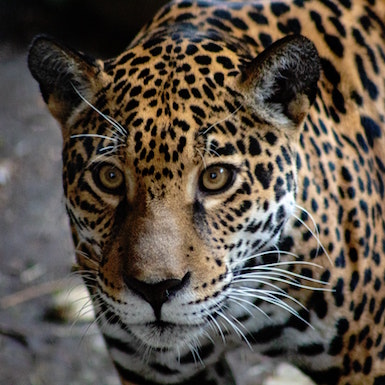Jaguar Facts, At A Glance
By Irina Bright.
This article is part of our Environment section
See the complete list of all our Articles about Rainforest Animals here.
Here is a summary of the most relevant jaguar facts pulled from different sources.
 Photo: Joshua J. Cotten
Photo: Joshua J. Cotten
• The Jaguar’s scientific name is Panthera Onca.
• It is closely related to the leopard and looks very much like it.
• Jaguar is a mammal and one of the largest cats in the world (third largest after tigers and lions).
• Range: from south western US across Central America to Paraguay.
• Habitat: mainly tropical rainforests but also open areas (mostly close to water sources).
• Current Estimated Jaguar Population: 15,000 individuals. (Ref. 1)
• Coat: tanned / dark yellow cover, with rosettes encapsulating dark spots in the middle. A jaguar's spotting pattern is unique to each individual. Occasionally variations in coat colour include black and white though the spots can always be seen.
• Dimensions: 30 – 150 kg in weight and length – 1.62–1.83 cm plus a tail of 75 cm. Males are typically 10 – 20% larger than females.
• Forest Jaguars: normally darker and smaller than the ones found in open areas.
• Diet: favourite “meals” are peccaries, capybaras, deer, birds, crocodilians, fish etc. In total, more than 85 different prey. (Ref. 2)
• Unprovoked attacks on humans are rare. (Ref. 3)
• Threats: the loss of habitat (such as rainforests) and poaching as well as “revenge killings” by cattle ranchers (in case of jaguars eating livestock due to lack of their natural prey)
• Status: Near Threatened. (Ref. 4)
Written by: Irina Bright
Original publication date: 2007
Republication date: 2020
Main Reference:
Jaguar. (September 24, 2007). In Wikipedia, The Free Encyclopedia. Retrieved September 24, 2007 from http://en.wikipedia.org/w/index.php?title=Jaguar&oldid=160017231
Other References:
1. Rainforest2Reef (2007). Rainforest | Jaguar | Exotic Animals | Migratory Birds. Retrieved December 3, 2007 from http://www.rainforest2reef.org/research_wildlife.html
2. Cohn, J. P. (September/October, 2002). Cat in a Hot Spot: With New Sightings and Research, Ecotourism and Ranching Programs Are Offering Innovative Solutions to Recover and Protect the Threatened Jaguar. Americas (English Edition), Vol. 54. Retrieved September 24, 2007 from Questia.com
3. Allen, W. (2003). Green Phoenix: Restoring the Tropical Forests of Guanacaste, Costa Rica. New York: Oxford University Press, p. 22. Retrieved September 24, 2007 from Questia.com
4. Cat Specialist Group 2002. Panthera onca. In: IUCN 2007. 2007 IUCN Red List of Threatened Species. Retrieved September 24, 2007 from www.iucnredlist.org